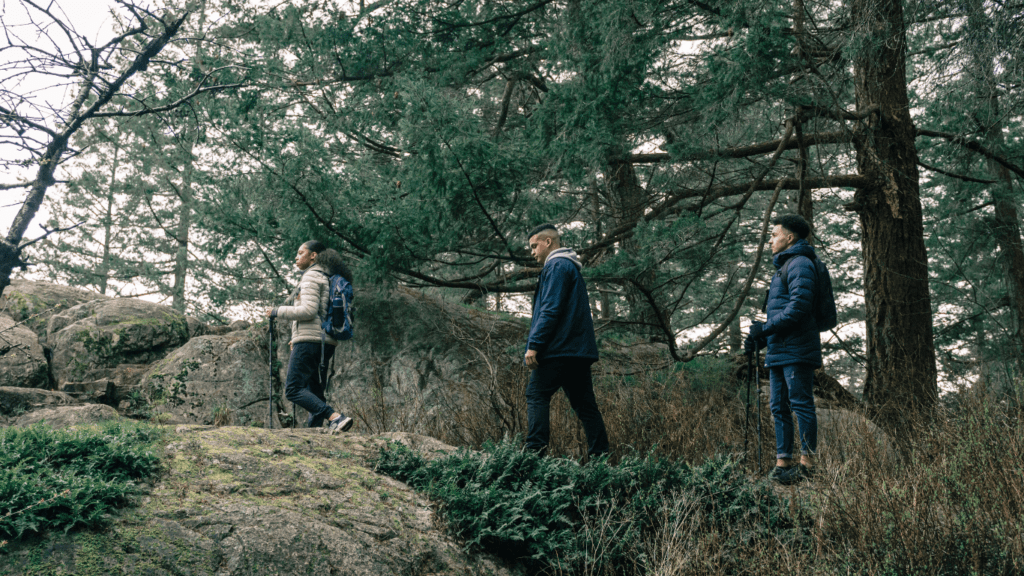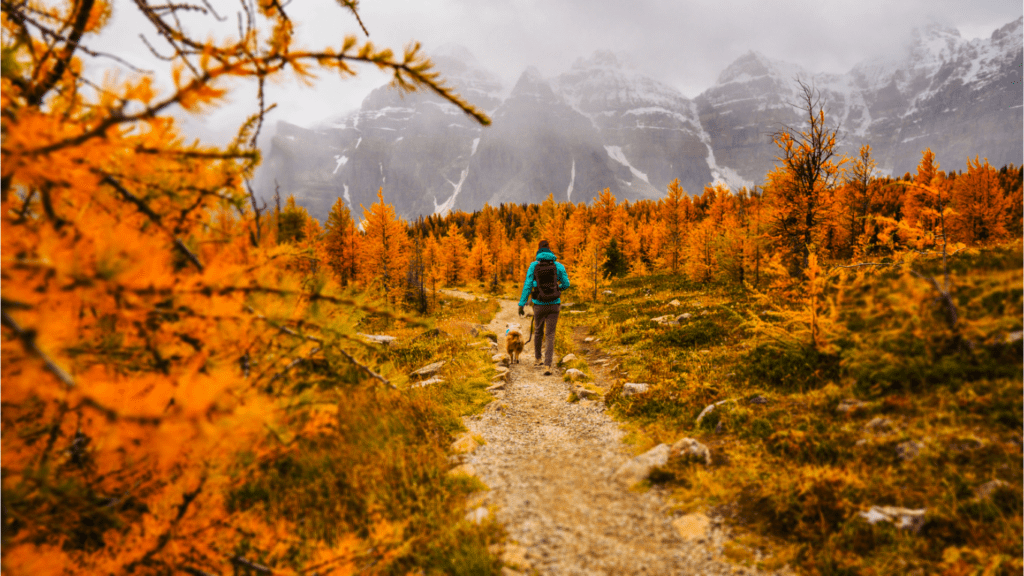Understanding Seasonal Hiking
Seasonal hiking involves recognizing the unique attributes each time of year brings to the trail. Understanding these can improve your hiking experience immensely.
Benefits of Hiking in Different Seasons
Hiking offers distinct benefits depending on the season. In spring, vibrant blooms can be observed, providing colorful landscapes. During summer, long daylight hours allow for extended treks. Adventure and solitude are common in fall, with cooler temperatures and stunning foliage. In winter, snow-covered trails provide a serene hiking environment and opportunities for unique photography.
Factors to Consider
When planning a hike, take several seasonal factors into account. Weather patterns vary throughout the year, affecting trail conditions. Wildlife activity changes with the seasons, requiring different safety measures. Daylight availability influences how early or late one can start a hike. Additionally, popular trails may be crowded in peak seasons, impacting the overall hiking experience.
Spring Hiking
Spring hiking captivates with its vibrant blooms and rejuvenated landscapes. Understanding the season’s pros and cons boosts overall enjoyment.
Pros and Cons
Pros:
- Flora: Spring flowers, such as wildflowers and cherry blossoms, are in full bloom. Trails transform into picturesque scenes.
- Fauna: Increased wildlife activity, including sightings of deer, birds, and other animals, defines the season.
- Weather: Mild temperatures offer a comfortable hiking climate, preventing overheating common in summer.
Cons:
- Mud: Spring thaw and rainfall lead to muddy trails, creating slick conditions.
- Allergies: Blooming plants release pollen, aggravating allergies for sensitive individuals.
- Unpredictable Weather: Sudden rain showers and fluctuating temperatures require hikers to stay prepared.
Key Tips for Spring Hikes
Layer clothing. The temperature varies greatly in spring. Wear moisture-wicking base layers and pack a waterproof jacket. Choose trails carefully. Opt for well-draining paths to avoid mud. Popular choices include higher elevation trails with rocky terrain. Stay updated on weather forecasts. Sudden changes in conditions, common in spring, can catch hikers off guard. Carry essential gear. Bring bug spray and sunscreen. The mixture of warmth and humidity can invite insects and UV exposure. Respect wildlife. Increased animal activity means more encounters. Maintain a safe distance to avoid disturbing them.
Spring offers unique hiking experiences with its dynamic environment. Planning and preparation maximize enjoyment while minimizing risks.
Summer Hiking
Summer hiking offers a unique set of benefits and challenges. It’s important to recognize these factors to make the most of your summer adventures.
Pros and Cons
Pros:
- Extended Daylight – Summer days provide longer daylight hours, ideal for extended hikes.
- Variety of Trails – More trails are accessible due to snowmelt and favorable weather.
- Warmer Temperatures – Hiking in warmer temperatures allows for lighter packing and easier mobility.
- Scenic Views – Clear skies and vibrant ecosystems enhance the visual experience.
Cons:
- Heat – High temperatures can lead to dehydration and heat-related illnesses.
- Crowded Trails – Popular trails see increased foot traffic during the summer.
- Bugs – Insects like mosquitoes and ticks are more active.
- Thunderstorms – Afternoon storms can develop rapidly, posing a risk to hikers.
- Hydrate Frequently – Drink water regularly to prevent dehydration. Electrolyte drinks can also help.
- Start Early – Begin hikes early in the morning to avoid the harsh midday sun.
- Wear Sunscreen – Use sunscreen with high SPF to protect against harmful UV rays.
- Dress Appropriately – Wear light, moisture-wicking clothing to stay cool and comfortable.
- Bring Bug Repellent – Use insect repellent to protect against bites from mosquitoes, ticks, and other insects.
- Monitor Weather – Check weather forecasts regularly and plan to avoid thunderstorms.
- Consider Altitude – Higher altitudes may offer cooler temperatures but require acclimatization.
Every summer hike presents its unique challenges and rewards. With the right preparation and mindfulness, you can enjoy the beauty and excitement that summer trails offer.
Fall Hiking

Fall hiking offers cooler temperatures and breathtaking foliage. This season provides an unparalleled backdrop for outdoor enthusiasts looking to enjoy serene and colorful trails.
Pros and Cons
Pros:
- Cool Temperatures: Fall brings relief from the summer heat, making hikes more comfortable.
- Stunning Foliage: Trees display vibrant reds, oranges, and yellows, enhancing the scenic beauty.
- Fewer Bugs: Cooler weather reduces the presence of insects like mosquitoes and ticks.
- Less Crowded Trails: As summer ends, popular trails become less crowded.
Cons:
- Shorter Daylight Hours: Days become shorter, limiting the time available for longer hikes.
- Unpredictable Weather: Fall weather can change rapidly, with sudden rain or early snow.
- Falling Leaves: Trails can be slippery due to fallen leaves, increasing the risk of slipping.
- Cooling Temperatures: Mornings and evenings can be much cooler, requiring additional layers.
- Dress in Layers: Wear moisture-wicking base layers, insulating middle layers, and a waterproof outer layer to adapt to changing temperatures.
- Start Early: Begin hikes early to take advantage of the available daylight.
- Check Weather Forecasts: Stay updated on local weather to prepare for sudden changes.
- Use Trekking Poles: Poles can provide extra stability on leaf-covered trails.
- Bring a Headlamp: Always have a headlamp or flashlight in case your hike extends into dusk.
- Stay Hydrated: Cooler temperatures don’t eliminate the need for hydration; carry sufficient water.
- Carry a Map: Fallen leaves can obscure trail markers, so have a map or GPS device handy.
Winter Hiking
Winter hiking offers an entirely different experience, transforming trails into peaceful, snow-covered landscapes. Understanding the unique pros and cons of winter hiking helps ensure a safe and enjoyable adventure.
Pros and Cons
Pros:
- Scenic Beauty: Snow-covered trees and landscapes provide stunning visuals ideal for photography.
- Solitude: Fewer hikers mean a quieter, more peaceful trail experience.
- Wildlife Visibility: Track wildlife more easily due to animal prints in the snow.
Cons:
- Cold Temperatures: Hikers face the challenge of staying warm, especially in the early mornings and evenings.
- Shorter Days: Limited daylight hours reduce the time available for hiking.
- Trail Conditions: Snow and ice increase the risk of slipping and require proper equipment.
- Dress in Layers: Wear moisture-wicking base layers, insulating mid-layers, and a waterproof outer layer to manage body temperature.
- Use Appropriate Gear: Invest in traction devices like microspikes or crampons and use trekking poles for stability on icy trails.
- Stay Hydrated: Cold weather can be deceiving, but dehydration remains a risk, so drink water regularly.
- Plan for Shorter Days: Start hikes early to maximize daylight, and always carry a headlamp in case you finish later than expected.
- Check Weather Forecasts: Winter weather can change rapidly, so monitor forecasts and be prepared to turn back if conditions worsen.
- Carry Essential Gear: Bring extra clothing, a map or GPS device, and emergency supplies, including a space blanket and first-aid kit.
By embracing the season’s uniqueness and preparing adequately, winter hiking can be a memorable and exhilarating experience.
Personalizing Your Hiking Preferences
Understanding one’s hiking preferences can maximize enjoyment. Each season offers unique experiences and knowing what you enjoy most can help tailor your adventures.
Assessing Your Fitness Level
Identifying one’s physical capabilities is essential. Different seasons present various physical demands:
- Spring (mild hikes with vibrant blooms): Moderate fitness levels needed
- Summer (extended daylight hours): Higher stamina required due to heat
- Fall (cool temperatures with scenic foliage): Moderately challenging, occasional wet trails
- Winter (snow-covered trails): High endurance necessary due to cold and snow
Knowing your fitness level helps select the best season and trail difficulty.
Considering Preferred Scenery
Everyone has different aesthetic preferences:
- Spring: Wildflowers and fresh greens
- Summer: Clear skies and lush landscapes
- Fall: Vibrant autumn foliage
- Winter: Serene, snowy vistas
Choosing the season based on preferred scenery enhances hiking satisfaction.
Evaluating Temperature Tolerance
Comfort with various temperatures impacts hiking enjoyment:
- Spring: Mild temperatures, ideal for layering
- Summer: Warm to hot, suitable for those who tolerate heat
- Fall: Cool to brisk, perfect for layered clothing
- Winter: Cold, necessitates warm gear and higher tolerance to cold
Match temperature preference with the appropriate season for a comfortable hike.
Determining Solitude vs. Social Experience
Decide if you prefer solitude or social experiences on trails:
- Solitude: Winter and late fall for fewer crowds
- Social: Summer and spring bring more hikers, ideal for meeting people
Select hiking times based on social preferences for a more enjoyable experience.
Considering Wildlife Interests
Different seasons offer varied wildlife activity:
- Spring: Rebirth of flora and fauna
- Summer: High activity of animals
- Fall: Migration patterns visible
- Winter: Tracks in snow reveal animal movements
Align hiking with seasons that match wildlife interests for enriching encounters.
Factoring Weather Preferences
Weather conditions greatly influence hiking:
- Spring: Unpredictable but mild weather
- Summer: Consistently warm with occasional storms
- Fall: Stable but variable temperatures
- Winter: Cold and potentially harsh
Select seasons based on weather preferences to avoid discomfort and risks.
By understanding these personal factors, hikers can customize their experiences to align with individual preferences, ensuring a more fulfilling outdoor adventure.



 Mindfulness & Nature Wellness Specialist
Eve Macleod is a certified mindfulness and meditation instructor who has spent years cultivating her passion for connecting wellness practices with the natural world. At Whisper Forest Ways, Eve focuses on guiding readers through techniques that harness the power of nature to promote mental, emotional, and physical well-being. Specializing in forest bathing, nature-based meditation, and eco-therapy, Eve helps readers discover how nature can enhance mindfulness practices and deepen relaxation. She believes that the natural world holds untapped potential for personal healing, stress relief, and spiritual growth, and through her articles and tutorials, she invites everyone to embark on a journey toward a more peaceful and centered life.
Mindfulness & Nature Wellness Specialist
Eve Macleod is a certified mindfulness and meditation instructor who has spent years cultivating her passion for connecting wellness practices with the natural world. At Whisper Forest Ways, Eve focuses on guiding readers through techniques that harness the power of nature to promote mental, emotional, and physical well-being. Specializing in forest bathing, nature-based meditation, and eco-therapy, Eve helps readers discover how nature can enhance mindfulness practices and deepen relaxation. She believes that the natural world holds untapped potential for personal healing, stress relief, and spiritual growth, and through her articles and tutorials, she invites everyone to embark on a journey toward a more peaceful and centered life.
